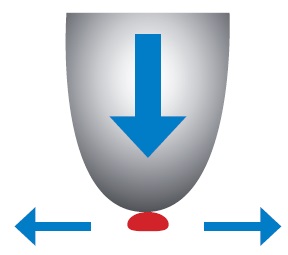Nudging nanoscale objects
Drs. Wilfred T. Tysoe & Nicholas D. Spencer | TLT Cutting Edge October 2010
‘Tip-on-top’ method allows for more precise positioning and measurement of interfacial friction.

If the frictional force between a tip placed on top of a nanoparticle is larger than the force required to slide the particle on the substrate, it will simply move with the tip.
The conventional approach to measuring nanoscale friction using an atomic force microscope (AFM) is to bring a tip down onto a surface and measure the lateral force during sliding from the torsion of the cantilever. While this method is capable of precisely measuring miniscule friction forces, it can suffer from disadvantages due to uncertainties in the tip structure or cleanliness.
Over the past few years, an alternative approach has been used in which a nanoparticle deposited onto the surface is moved by an AFM tip. This allows the friction of a wide range of materials to be measured on clean, well-defined surfaces. This approach also offers the possibility of fashioning nanostructured arrays. It would seem that the obvious way to carry out this experiment is to place the AFM tip next to the nanoparticle and simply push it to a desired location. However, unless the tip is placed exactly at the center of the nanoparticle, the particle has a tendency to move sideways, making it difficult to precisely manipulate it.
This issue has been addressed through experiments performed by Dirk Dietzel and André Schirmeisen’s group at the University of Munster in cooperation with Udo Schwarz at Yale University. They developed a simple geometrical model for pushing nanoparticles that calculates the particle trajectory as a function of the relative impact parameter (the distance of the tip from the center of the particle, ratioed to the particle diameter). The simple model is verified experimentally using antimony as well as gold nanoparticles. For example, for a relative impact parameter of only 5%, the particle is completely pushed aside after moving only three times the particle radius.
To solve the problem, the authors suggest an alternative strategy: “tip-on-top” manipulation. They theorize that if the frictional force between a tip placed on top of a nanoparticle is larger than the force required to slide the particle on the substrate, it will simply move with the tip. At the same time, the cantilever torsion can be interpreted as a measure of the interfacial friction between the nanoparticle and the substrate. They tested this idea using antimony nanoparticles on a highly oriented, pyrolytic graphite substrate and found that, indeed, they could precisely manipulate the antimony particle at will, which accurately followed the motion of the AFM tip if the tip exerts sufficient load.
This raises the question of whether the additional load exerted by the AFM tip will influence the interfacial friction. To test whether this was the case, the lateral force required to push the particle in the conventional way was measured. The lateral force to slide the tip on the graphite surface served as a reference, and the increase in force, ~62 nanoNewtons (nN) when the tip encountered the sample, was taken to be the interfacial friction.
In the case of the tip-on-top method, there is no such internal reference. To solve this problem, the authors measured the difference in the forces needed to push the particle forward and backward, which represents twice the friction force, leading to a value of 64nN in excellent agreement with that measured by pushing. Indeed, no influence of normal force was found in any of the friction measurements. This observation was rationalized by arguing that the cantilever normal forces (of ~10 nN) resulted in only very small increases in pressure between the nanoparticle and substrate (<1 pN/nm
2) so that the interface is not changed.
This strategy not only provides a precise method for nanoparticle manipulation, it also allows friction to be measured on the same particle as a function of a wide range of parameters such as sliding velocity and sliding direction. It even can investigate the onset of nanoparticle wear processes.
FOR FURTHER READING:
Dietzel, D., Feldmann, M., Herding, C., Schwarz, U.D. and Schirmeisen, A. (2010), “Quantifying Pathways and Friction of Nanoparticles During Controlled Manipulation by Contact-Mode Atomic Force Microscopy,”
Tribology Letters,
39 (3), pp. 273-281.
 Eddy Tysoe is a Distinguished Professor of Physical Chemistry at the University of Wisconsin-Milwaukee. You can reach him at wtt@uwm.edu
Eddy Tysoe is a Distinguished Professor of Physical Chemistry at the University of Wisconsin-Milwaukee. You can reach him at wtt@uwm.edu.
 Nic Spencer is professor of surface science and technology at the ETH Zurich, Switzerland. Both serve as editors-in-chief of STLE-affiliated Tribology Letters journal. You can reach him at nspencer@ethz.ch
Nic Spencer is professor of surface science and technology at the ETH Zurich, Switzerland. Both serve as editors-in-chief of STLE-affiliated Tribology Letters journal. You can reach him at nspencer@ethz.ch.